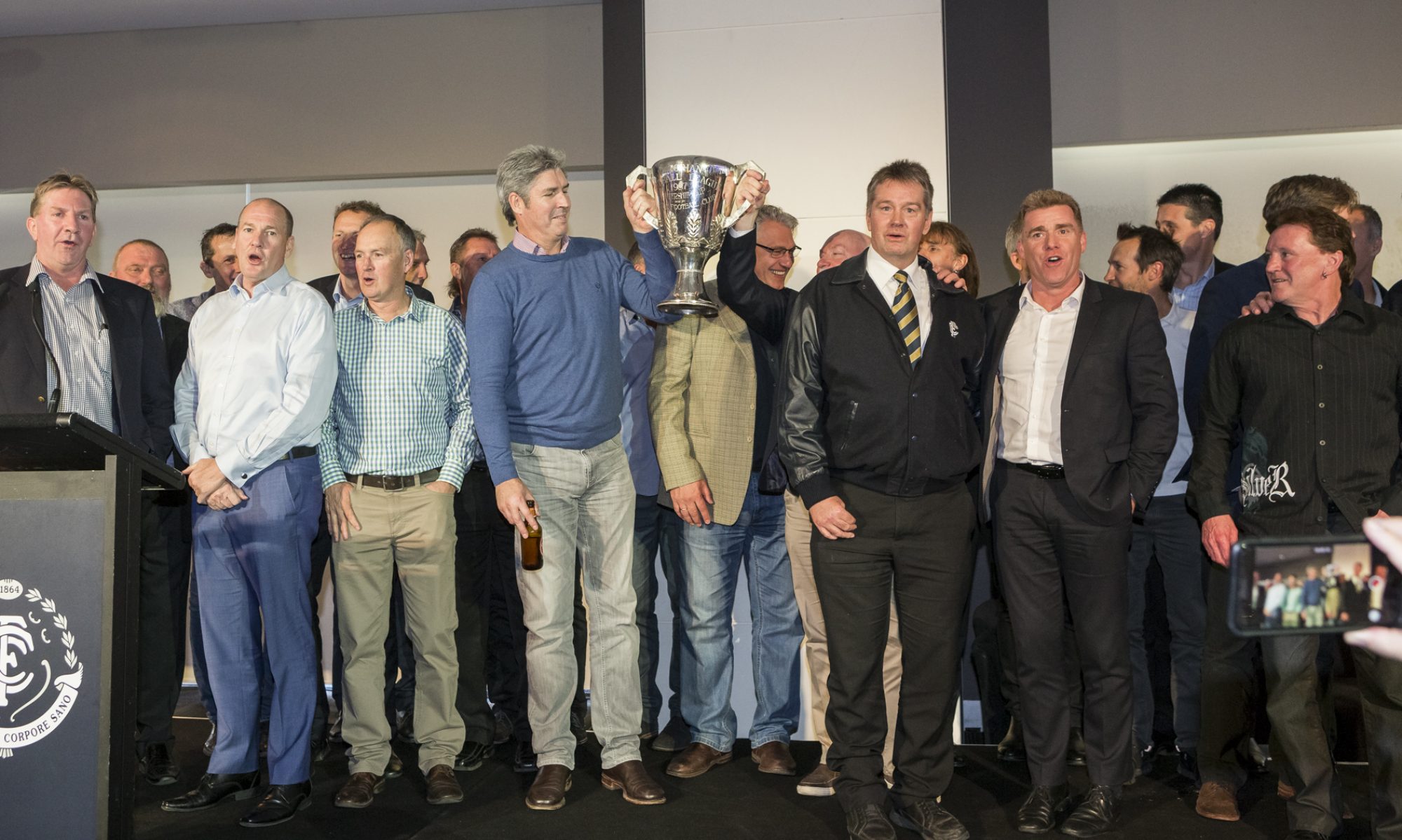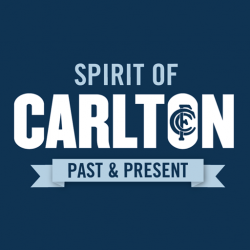About 120 clicks northwest of Melbourne, the town of Castlemaine boasts nearly 7000 residents, but back in the gold rush days of the 1850s it could boast that it had a bigger population than Melbourne. Those days are long gone, as is the majority of the gold. However, over the years the Carlton Football club has found more than a few of their own golden nuggets in the form of fine players.
Warren Jones
Warren “Wow” Jones added more than his share to the rich tapestry of the Carlton Football Club in his 92 games for the Blues between 1978 and 1985. Perhaps best remembered for the myth that grew from his nickname, Wow was a heavily-tattooed giant at 200 cm and 102 kg – but one whose forbidding appearance hid a surprisingly gentle nature off the field.
Jones was born in Wellington New Zealand, before growing up in Queensland. He learned the Australian game with Morningside Football Club, and later moved south to Castlemaine in central Victoria. When Carlton recruited him, he was a match-hardened 24 year-old whose determination and ruck skills – especially his palming of the ball to his rovers – made him the ideal back-up for Mike Fitzpatrick. Jones was handed the fabled number 2 guernsey, and didn’t disappoint. During his eight seasons with the Blues, he represented Queensland in 1979 and played in seven finals, including his finest moment; the 1982 Grand Final. In an epic match, Wow was one of the keys to Carlton’s upset win over Richmond when he almost single-handedly took on and subdued the Tiger ruck duo of Mark Lee and David Cloke.
http://www.blueseum.org/tiki-index.php?page=Warren+’Wow’+Jones
Adrian Bassett
Adrian Bassett was a lightly-built and pacey left-footed defender who was one of two players drafted by Carlton from VFA club Coburg in the 1990 VFL Pre-Season Draft. The other was Tim Rieniets, who like Bassett, had been a dominant force in Coburg’s 1988-89 Premiership double triumph over Williamstown. Bassett was taken at selection 13, and Rieniets at number 27.
When Bassett was drafted by the Carlton, it was his second stint at the Blues. He had previously played with the U/19’s and Reserves but had been delisted, the Blues had drafted him from Castlemaine (he had previously played with Campbell’s Creek). His move to Southport (QLD), and then to the Phil Cleary led Coburg gave him the experience and confidence for another crack with Carlton.
http://www.blueseum.org/tiki-index.php?page=Adrian+Bassett
Stephen Oliver
The highlight of his brief career was surely the Round 14 game in 1993 away to West Coast. An early injury in the game to ‘Sticks’ Kernahan provided Oliver with a rare chance to start out of the goalsquare, and he showed Carlton fans what the hype was all about. He dismantled the premier backman of the competition at the time, Glenn Jakovich, with a display which highlighted his aerial prowess and eye for goal. Two of his nine marks for the day were out and out ‘screamers,’ whilst he kicked two goals and provided assists for another two.
The game is also remembered for another vintage display from Greg Williams (30 possessions, 3 goals) and the last-minute, boundary line set shot from Eagle wingman Chris Mainwaring which struck the post. The one-point victory to Carlton over the reigning premiers would go a long way to establishing the team as genuine finals contender.
Alas for the Blues, Oliver had had enough of city life and the grind of commuting to Melbourne for each training session, and so decided to stay home in the bush for good. In 1995 he took up the role as playing coach for his beloved Castlemaine.
http://www.blueseum.org/tiki-index.php?page=Stephen+Oliver
Peter Hall
Peter rounded off his career at Carlton in 1974, playing another 11 games before he and fellow fringe dweller Lance Styles were cleared to West Australian club Subiaco, as part of the wheeling and dealing to get champion ruckman Mike Fitzpatrick to Princes Park. But after only a brief stay in the west, Hall returned to Victoria and graduated from Monash with majors in Mathematics and Psychology. He then accepted an offer to captain-coach prominent LaTrobe Valley club Traralgon for the 1976 season, while also beginning a new working life in the provincial centre as a secondary school teacher. His new adventure in the bush was to prove spectacularly successful.
At Traralgon, he twice won the league’s Best and Fairest player award, while coaching his team to the 1978 and 1980 Premierships. He then switched clubs to Morwell, and took the Latrobe Valley Tigers to another flag in 1985.
In 1988 – on the back of his high profile and sporting success – he stood for election to Parliament as a National Party candidate and won his seat with a comfortable majority. Since then, he has risen to hold a number of senior positions with the Nationals – in particular, as Party Leader in the Legislative Council, holding the shadow portfolios of Education and Resources and Environment. On election to Government in November 2010, Peter was appointed Minister for Higher Education and Skills and Minister responsible for the Teaching Profession
http://www.blueseum.org/tiki-index.php?page=Peter+Hall
Arthur Cummins
Arthur Cummins’ short playing career was remarkable on two counts. First, because he was a member of Carlton’s original VFL team, and second because his seven consecutive games were played against seven different opponents at seven separate venues.
Born in Castlemaine in central Victoria in 1876, Arthur Edward Cummins was already established at Princes Park by 1897, when the Blues defected from the Victorian Football Association to become one of eight foundation clubs in the Victorian Football League.
The VFL played its opening round of matches on Saturday, May 8, 1897. Carlton met Fitzroy at the Brunswick Street Oval, with Cummins in a forward pocket – apparently as an optional marking target alongside our fast-leading full-forward Wally O’Cock. However, that strategy wasn’t successful. Fitzroy were too good all over the ground and won by five goals. In succeeding weeks, as the Carlton Football Club took its first faltering steps on the long road to eventual glory, defeat followed defeat. In round four against Geelong at Corio Oval, Cummins had a rare moment of joy when he slotted his only career goal, and a fortnight later celebrated his one victory as a Blue when Carlton beat St Kilda by 11 points in a torrid encounter at the Junction Oval.
His seventh and last game provided another first for Cummins when he took part in Carlton’s debut match on the hallowed turf of Princes Park on June 22, 1897. Inspired by the occasion, the Blues put up one of their best performances of the season, before falling to Collingwood by four points in a high-quality encounter.

